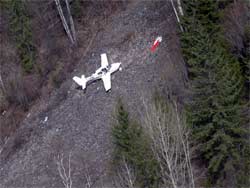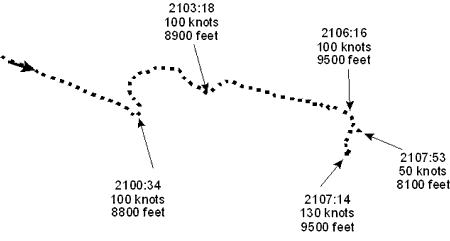Loss of Control / Parachute System Descent
Cirrus Design SR20 C-GEMC
Mount O'Leary, British Columbia
The Transportation Safety Board of Canada (TSB) investigated this occurrence for the purpose of advancing transportation safety. It is not the function of the Board to assign fault or determine civil or criminal liability. This report is not created for use in the context of legal, disciplinary or other proceedings. See Ownership and use of content. Masculine pronouns and position titles may be used to signify all genders to comply with the Canadian Transportation Accident Investigation and Safety Board Act (S.C. 1989, c. 3).
Summary
At approximately 2030 Pacific daylight time, the Cirrus SR20 (registration C-GEMC, serial number 1241) with the pilot and three passengers on board, took off on a night VFR (visual flight rules) flight from Kelowna, British Columbia to Lethbridge, Alberta having originated in Seattle, Washington. The aircraft was climbing through 8800 feet above sea level (asl), when it veered quite sharply to the left. The pilot corrected the heading and continued the climb. About 45 seconds after resuming heading, the aircraft again veered to the left; again the pilot corrected the heading. Three minutes later the aircraft reached the cruising altitude of 9500 feet asl. Approximately one minute later, with the autopilot engaged, the aircraft rolled 90 degrees to the left. The pilot disconnected the autopilot, but found himself in a spiral dive from which he was unable to recover. He shut down the engine and deployed the Cirrus airframe parachute system (CAPS).
At approximately 2111, the aircraft/parachute landed on a steep mountainside on the southern slope of Mount O'Leary, British Columbia at the 2300-foot level. The aircraft sustained substantial damage, but there were no injuries. A search and rescue operation was initiated. The four occupants were found and rescued early the following morning and returned to Kelowna by military helicopter.
Factual information
The pilot held a private pilot licence issued by Transport Canada and endorsed for single-engine land aeroplanes, night, and VFR OTT (over-the-top). The pilot's medical certificate had a restriction that glasses must be worn while flying and indicated that the last medical was conducted on 06 December 2002, valid for 24 months. The pilot had accumulated approximately 1900 flying hours on light, single-engine aircraft, including 350 hours on the Cirrus SR20.
During the climb, the aircraft had a tendency to veer to the left, so the pilot checked the fuel tanks for balance. The left-wing tank was more than ¾ full and the right-wing tank less than ½ full, so he selected the left tank. Later, at a time when he would normally have switched tanks, the fuel gauges showed that the left tank still had more fuel than the right tank, so he left the selection on the left tank.
Records indicate that the aircraft was certified, equipped, and maintained in accordance with existing regulations and approved procedures. The aircraft was manufactured in 2002 and had flown a total of 336.1 hours before the accident flight. A review of the airframe, engine, and propellor logbooks showed nothing remarkable. The engine, a Continental IO-360-ES, serial number 357481, had accumulated 336.1 hours since new.
Damage to the aircraft was mainly to its underside, and the nosewheel leg was broken. The engine crankshaft was damaged when a propellor tip contacted the ground. The right door was torn off during the CAPS deployment and was not found.
It was impossible to examine the aircraft where it came to rest due to the precarious nature of the terrain. The aircraft was airlifted by helicopter to a secure site near the town of Edgewood, British Columbia where the airframe, engine, propellor and systems were examined for pre-accident defects. The emergency locator transmitter (ELT) was armed but did not activate. It was tested and found to be capable of transmitting. The elevator trim was found in the full nose-down position. The fuel remaining in both fuel tanks was drained: 38 litres from the left tank and 55 litres from the right tank.
Later, the aircraft was moved by road to the owner's hanger in Picture Butte, Alberta where the examination for pre-accident defects was continued; none was found. The autopilot was removed for bench testing. All functions were found to be normal. The autopilot aileron trim actuator was found in the full right-wing down position. The turn coordinator was bench tested for function and autopilot outputs, and was found to be serviceable. The artificial horizon and horizontal situation indicator were not tested because the autopilot is not connected to either unit.
Baggage and equipment were removed from the aircraft and weighed at 39.7 pounds using certified scales. Using information provided by the pilot, the aircraft's weight at take-off from Seattle was calculated to be approximately 3235 pounds, 235 pounds over the maximum allowable take-off weight (MTOW) of 3000 pounds. The centre of gravity (C of G) was calculated to be 29.72% of the mean aerodynamic chord (MAC); the allowable C of G range was 23% to 31.25% MAC. The calculations were repeated for the take-off from Kelowna, and the aircraft weighed approximately 3060 pounds, 60 pounds over the MTOW with the MAC at 28.95%. Calculations indicate the aircraft was within its weight and C of G limitations at the time of the occurrence.
The impact forces were not great enough to activate the armed ELT. A switch in the cockpit permits manual activation, but this switch could not be reached safely after the accident. The Pilot's Operating Handbook and FAA Approved Airplane Flight Manual for the Cirrus Design SR20 states in Section 3, Emergency Procedures, that after deploying the parachute, the ELT is to be selected On.
Radar data show that the aircraft was first detected at 2043:56 Pacific daylight timeFootnote 1 at a position 13 nautical miles (nm) southeast of Kelowna Airport, on an east-southeast heading, climbing through 5700 feet, with a ground speed of 100 knots. The aircraft climbed steadily on that heading until 2100:34 when, at an altitude of 8800 feet and a ground speed of 100 knots, it made a fairly abrupt turn to the left reaching a heading of 325° True (T) before correcting back to the east-southeast heading. At 2103:18 the aircraft made another left turn, reaching a heading of 052° T before again correcting to the east-southeast heading. At 2106:16, the aircraft reached 9500 feet and 25 seconds later began a turn to the south. At 2107:14 the event began. The last radar return was at 2107:53 as the aircraft descended through 8100 feet.
At 2100, 11 minutes before the accident, the reported weather at Castlegar, British Columbia, 32 nm southeast of the accident site, was as follows: wind 360° T at 8 knots; visibility 15 statute miles (sm); broken clouds at 9000 feet; temperature 12°C; dew point 3°C; altimeter setting 30.16; remarks: 5 oktasFootnote 2 altocumulus, last observation, next at 0600, sea level pressure 1022.0 hectopascals.
The graphical area forecast for the area between Kelowna and Cranbrook, British Columbia for 2300, 1 hour 49 minutes after the accident, called for the following conditions: scattered stratocumulus clouds based at 7000 feet asl topped at 12 000 feet asl; prevailing visibility more than 6 sm.
Upper air analyses at Kelowna covering the period of the accident indicate the winds at the 10 000 foot level were northerly at 16 knots.
Findings
Findings as to causes and contributing factors
- While cruising at 9500 feet with the autopilot engaged, the aircraft rolled 90 degrees, left wing down for undetermined reasons, causing the pilot to lose control of the aircraft.
Findings as to risk
- The armed ELT did not activate, due to the low impact forces, and was not manually turned on, making it difficult for the rescue helicopter crew to locate the downed aircraft.
- The aircraft was overweight on departure from Seattle, Washington and from Kelowna, British Columbia. Therefore, for all of the previous flight and for much of the occurrence flight it was being operated outside of the envelope established by the manufacturer's flight testing.
Other findings
- The CAPS system was successfully deployed and likely saved the occupants from fatal injuries.
Safety Concern
The aircraft's impact forces while being supported by the deployed parachute are not great enough to assure activation of the aircraft's ELT. For that reason, the Pilot's Operating Handbook and FAA Approved Airplane Flight Manual for the Cirrus Design SR20 state that after deployment of the parachute, the ELT is to be selected On.
The Board is concerned that after losing control of an aircraft and deploying the parachute, the pilot may not remember to activate the ELT. Not having some form of automatic ELT activation increases the risk that the pilot will not be found in time.
This report concludes the Transportation Safety Board's investigation into this occurrence. Consequently, the Board authorized the release of this report on .

